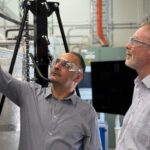Researchers from Curtin University’s Space Science and Technology Centre (SSTC) have accomplished the rare feat of building their own pocket-sized satellite, which they will launch on a re-supply rocket to the International Space Station to be released into orbit.
Known as a cubesat, the technology will be fully tested on the ground before launching next year, with the European Space Agency (ESA) partnering with Curtin to provide mission control capability for the project.
The project is part of a larger program, christened ‘Binar’ after the Noongar word for ‘fireball’, which aims to advance both WA industry and research, helping to build the State’s space engineering capabilities, and eventually fly a WA mission to the Moon.
Curtin University Vice-Chancellor Professor Deborah Terry congratulated SSTC Director and John Curtin Distinguished Professor Phil Bland and his team on their achievement in building their own miniaturised satellite to be tested in orbit.
“The fact that a major international space exploration organisation such as the European Space Agency has agreed to partner with Curtin on this project is a tremendous endorsement of the high calibre of scientific expertise we have at our Space Science and Technology Centre,” Professor Terry said.
Professor Bland, from Curtin’s School of Earth and Planetary Sciences, said a Curtin team of 12 staff and student engineers developed the miniaturised satellite.
“The Curtin team has managed to put all the systems required to operate the satellite, including the power, computer, steering and communications, on a single eight-layer printed circuit board, which at 10cm by 10cm by 2.5cm is about the size of a rather small sandwich,” Professor Bland said.
“Having everything on a single circuit board means there is more room for what the satellite is carrying, which in this case will be a camera that will capture beautiful images of Australia taken from orbit.”
Professor Bland said the other advantage of developing such a compact single-circuit board system was that it presented a more cost-effective alternative than those currently being produced by other manufacturers.
SSTC is preparing for a sub-orbital cubesat launch from the United States of America in the coming months, which will be a full test of Curtin’s first spacecraft, followed by a launch into low Earth orbit, from the International Space Station, next year.
The SSTC research team will spend months testing the cubesat in preparation for the sub-orbital launch, which will include the use of special vacuum chambers at Curtin University in order to simulate conditions in space.
Through the cubesat project, SSTC will be contributing to the SmartSat CRC, which is a consortium of industry and research organisations, including Curtin University, that is aiming to develop game-changing technologies to boost Australia’s space industry.
Last year, NASA launched cubesats into deep space as part of the Mars Cube One project to test new communications and navigation capabilities for future missions. This was part of the NASA Mars InSight Mission, involving Curtin planetary scientist Dr Katarina Miljkovic.
Members of the Binar engineering team have previously developed deep-space qualified hardware for landers on Mars and Titan, and managed software engineering for ESA missions.
Curtin University’s Space Science and Technology Centre was announced late last year and further information about its missions, research, and personnel is available here.



